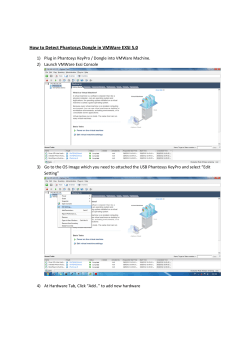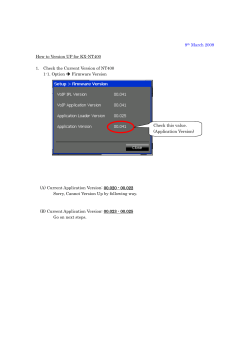
Purposes Linux Server (Web, FTP, File) on Vmware
CAELinux2008 Server (Web, FTP, File) on Vmware 13.10.2009 Linux Server (Web, FTP, File) on Vmware Purposes Many people want to use Linux but don't want to spend all their weekend in order to be familiar with this operating system. This file allows to share the way that I used in order to install a web, ftp and file server on Wmware. The linux used is CAELinux2008 based on PCLinuxOS2007. I'm beginner on Linux and I hope that this tutorial is made with simple language in order to share these information with many other beginners. Of course, comments about this file are welcome. Why CAELinux2008 Basically the installation for CAELinux2008 or PCLinuxOS2007 is almost similar. But CAELinux2008 provides many different engineering softwares (computation, CAD, FEM, CFD, ...). Moreover this distribution is based on PCLinuxOS2007, which propose an easy installation, can be used with a 32 bits processor (compared to CAELinux2009 which need 64 bits processor based on Ubuntu 8.04 LTS 64bit). If people are getting familiar with PCLinux2007 they will use more easily CAELinux2008 ! Index 1 Softwares References.........................................................................................................2 2 Software comparison Linux-Windows.................................................................................2 3 VM: Create a new virtual machine on Vmware..................................................................3 4 VM: Load the CAELinux2008.iso file..................................................................................3 5 Install Linux: Run the Live CD CAE Linux 2008.................................................................4 6 Install Linux: Install the CAE Linux 2008 on hard drive......................................................5 7 Install Linux: Restart CAE Linux 2008 from live to hard drive system................................6 8 Install Linux: Update CAE Linux 2008................................................................................7 9 Web Server: Setup............................................................................................................10 10 FTP Server: Setup...........................................................................................................11 11 File server: Setup............................................................................................................12 12 Figure..............................................................................................................................13 v1.0 1 - 37 Sébastien Thomas CAELinux2008 Server (Web, FTP, File) on Vmware 13.10.2009 1 Softwares References Vmware ESX Server 3i, 3.5.0 (http://www.vmware.com) VMware Infrastructure Client, 2.5.0 (http://www.vmware.com) CAE Linux 2008 (based on PCLinuxOS 2007, kernel 2.6.22.17) (http://www.caelinux.com) Notice that a part of this file is based on “CAELinux2007 Installation Manual” available on www.caelinux.com. 2 Software comparison Linux-Windows A short list which compare Linux and Windows softwares Linux Amarok Code Aster GproFtpd KFTPGrabber Koctave Krdc Ktorrent Kwrite Mythdvd Salomé Saturne WxMaxima v1.0 Windows MediaPlayer FEM software Typsoft FTP Server FileZilla Matlab (without free help file) Remote Desktop Control Utorrent NotePad DVD player CAD software CFD software Mathematica 2 - 37 Sébastien Thomas CAELinux2008 Server (Web, FTP, File) on Vmware 13.10.2009 3 VM: Create a new virtual machine on Vmware 3.1 3.2 3.3 3.4 3.5 3.6 It assumes that VMware is already installed Open VMware Infrastructure Client on the local machine Click on File / New / Virtual Machine ... Define a Typical install, Next (Figure 1) Define the virtual machine name, Next (Figure 2) Define the datastore used for this virtual machine, Next In this case only one hard disc is used (Figure 3) 3.7 Define a Linux, Other Linux (32-bit) machine, Next (Figure 4) 3.8 Define the memory size, Next This depends on your system but 1024 MB is recommended (Figure 5) 3.9 Choose the Network connection used for this virtual machine, Next (Figure 6) 3.10 Define the datastore size, Next. This depends on your system but 15 Go is the minimum recommended 3.11 Click Finish in order to install the new virtual machine (Figure 7) 4 VM: Load the CAELinux2008.iso file 4.1 4.2 4.3 4.4 4.5 4.6 4.7 4.8 4.9 4.10 4.11 4.12 4.13 4.14 4.15 4.16 4.17 4.18 4.19 4.20 v1.0 From your local computer, download the CAELinux2008.iso file from www.caelinux.com When the download is done, return to VMware Infrastructure Client Select the new virtual machine (previously created) Select the Summary tab on Vmware Infrastructure Client Click on datastore Click on the new virtual machine file Click on Upload files from your local machine to this datastore Click on Upload File and get the CAELinux2008.iso file from the local machine (Figure 8) Click Yes when the Upload/Download Operation Warning appears (Figure 9) Wait around 10 min in order to save the full .iso file Select the new virtual machine Select the Summary tab on Vmware Infrastructure Client Click on Edit Settings in Commands part Select the Hardware tab Click on CD/DVD Drive 1 Click Datastore ISO file in Device Type part and browse the CAELinux2008.iso file (Figure 10) Click on Connect at power on in Device Status part (Figure 11) Still in Virtual Machine Properties, click on SCSI Controller 0 Click on Change Type ... in SCSI Controller Type part Select BusLogic instead of LSI Logic (Figure 12) 3 - 37 Sébastien Thomas CAELinux2008 Server (Web, FTP, File) on Vmware 13.10.2009 5 Install Linux: Run the Live CD CAE Linux 2008 5.1 5.2 5.3 5.4 5.5 5.6 5.7 5.8 5.9 5.10 5.11 5.12 5.13 5.14 5.15 5.16 v1.0 On Vmware Infrastructure Client window click in the new virtual machine Select the Summary Tab Click Power On in order to start the virtual machine Answer Yes to the Virtual Machine Question (about change on SCSI) (Figure 13) Click Open Console in order to open this virtual machine Click in the console and select Live CD (to unselect the console, ctrl + alt (Figure 14) Select the keyboard layout, Next Select the timezone, Next Define the Date, Clock and Time Zone Settings, Next Select Ethernet as the connection that you want to configure, Next Select the network interface to configure, Next Select Automatic IP (BOOTP/DHCP) as the connection protocol, Next Keep the mark to Get DNS servers from DHCP. But unselect the mark to Assign host name from DHCP address ! Then define the Host name as localhost, Next (Figure 15) No change on the Connection control (Don't allow users to manage the connection, Start the connection at boot), Next Answer Yes to the question Do you want to start the connection now ? The network and Internet Configuration is done, Finish 4 - 37 Sébastien Thomas CAELinux2008 Server (Web, FTP, File) on Vmware 13.10.2009 6 Install Linux: Install the CAE Linux 2008 on hard drive 6.1 6.2 6.3 6.4 6.5 6.6 6.7 6.8 Log in with the root account, Enter, Username: root, Password: root (Figure 16)On desktop, click on Install PCLinuxOS The wizard to install CAE Linux 2008 starts, Next (Figure 17) Select the Normal Hard drive (ide, sata) as the type of hard drive to install the OS, Next (Figure 18) Select Custom disk partitioning, Next (Figure 19) Answer Continue for the backup message, OK (Figure 20) Under sda tab, click on white part Click Create in order to create the first partition Define ~1.5 GB for a Linux swap partition, OK (Figure 21) 6.9 6.10 6.11 6.12 Under sda tab, click on white part Click Create in order to create the second partition Define the maximum size for a Journalised FS: ext3 partition, OK (Figure 22) When these two partitions are created, Done (Figure 23) 6.13 6.14 6.15 Answer OK to the message before to format the partition (Figure 24) Click Next in order to format the partition (Figure 25) Click Next in order to install PC Linux OS 2008 on hard drive (Figure 26) 6.16 6.17 6.18 6.19 6.20 v1.0 After few minutes CAE Linux 2008 is installed and the bootload have to be defined. Grub with graphical menu is recommended, Next (Figure 27) Define linux as the boot default (no other OS is used on this virtual machine), Finish (Figure 28) Define the administrator (boot) password, Next Define an additional user (this step is not compulsory but recommended), Done. Notice that CAE user is already created and should not be deleted. A last message confirm the installation and ask to remove the live system and restart the computer, Finish 5 - 37 Sébastien Thomas CAELinux2008 Server (Web, FTP, File) on Vmware 13.10.2009 7 Install Linux: Restart CAE Linux 2008 from live to hard drive system 7.1 7.2 7.3 7.4 7.5 7.6 7.7 7.8 7.9 7.10 7.11 7.12 7.13 7.14 7.15 v1.0 Return to the Vmware Infrastructure Client by Ctrl+Alt (without closing the console) Click on the new virtual machine in VMware Infrastructure Client Click on Summary tab Click on Edit Settings On Hardware tab, click on CD/DVD Drive 1 Unselect Connect at power on in order to disconnect the .iso file, OK (Figure 29) Return to the console (which should be still open) Click on PC (1st button from the left bottom corner), Log Out ... Click on Turn Off Computer button Return to the Vmware Infrastructure Client by Ctrl+Alt When the virtual machine is stopped, select the virtual machine in Vmware Infrastructure Client and click on Power on. From now the virtual machine is running with CAE Linux OS on the hard drive. Return to the console and select Linux in the boot list (Figure 30). When the CAE Linux 2008 is starting, it is possible to click on ESC in order to see all steps. Log in as root user with the password previously defined (Figure 31) From now you are on CAE Linux 2008 desktop running on your hard drive (Figure 32) 6 - 37 Sébastien Thomas CAELinux2008 Server (Web, FTP, File) on Vmware 13.10.2009 8 Install Linux: Update CAE Linux 2008 8.1 8.2 8.3 8.4 8.5 8.6 8.7 Click on Synaptic button (6th button from the left bottom corner) in order to open the package manager Click on Search button Write mozilla-firefox, Search (Figure 33) Right click on mozilla-firefox package Click on Mark for Removal Click on Apply button Click Apply in order to accept the changes (Figure 34) 8.8 8.9 8.10 8.11 8.12 8.13 When the changes are applied, click Search button Write compiz, Search Right click on compiz package Click Mark for Removal Click on Apply button Click Apply in order to accept the changes 8.14 8.15 8.16 8.17 8.18 8.19 When the changes are applied, click Search button Write OpenOffice.org, Search Right click on OpenOffice.org package Click Mark for Removal Click on Apply button Click Apply in order to accept the changes 8.20 8.21 8.22 8.23 8.24 8.25 8.26 8.27 When the changes are applied, click Reload Click Search button Write GConf2, Search Right click on GConf2 package Click Mark for Upgrade (Figure 35) Click Mark in order to mark additional required changes (Figure 36) Click on Apply button Click Apply in order to accept the changes 8.28 8.29 8.30 8.31 8.32 8.33 8.34 8.35 8.36 When the changes are applied, click Search Click Search button Write gtk+2.0, Search Right click on gtk+2.0 package Click Mark for Upgrade Click Mark in order to mark additional required changes Click on Apply button Click Apply in order to accept the changes When the changes are applied, close Synaptic v1.0 7 - 37 Sébastien Thomas CAELinux2008 Server (Web, FTP, File) on Vmware 8.37 8.38 8.39 8.40 8.41 8.42 8.43 8.44 8.45 8.46 8.47 8.48 8.49 8.50 8.51 13.10.2009 Open Konsole (From the desktop or from PC/system/Terminals/Konsole) Write apt-get clean, Enter Write apt-get autoclean, Enter Write apt-get update, Enter Write apt-get upgrade, Enter. Answer Y to continue the upgrade, Enter (this step can spend around 15 min) When the update are done, write /etc/init.d/network restart, Enter Write apt-get dist-upgrade, Enter Answer Y to continue the upgrade, Enter (this step can spend around 15 min) 8.52 8.53 8.54 8.55 8.56 When the change are applied, reboot the system (PC/Log out.../Restart Computer) Select Boot PCLinuxOS (default) in the boot list Login as root Open Synaptic Click Search button Write kernel-latest, Search (If the step does not give any result, write kernel and choose the last one manually) Right click on kernel-latest package Click Mark for Installation (Figure 37) Click Mark in order to mark additional required changes Click on Apply button Click Apply in order to accept the changes 8.57 8.58 8.59 8.60 8.61 8.62 8.63 8.64 8.65 8.66 8.67 8.68 When the change are applied, reboot the system (PC/Log out.../Restart Computer) Select Linux with kernel 2.6.26.8.tex3 (default) in the boot list Login as root Open Synaptic Click Reload button Click Search button Write libgmime, Search Right click on libgmime2.4_2 package Click Mark for Installation Click Mark in order to mark additional required changes Click on Apply button Click Apply in order to accept the changes v1.0 8 - 37 Sébastien Thomas CAELinux2008 Server (Web, FTP, File) on Vmware 8.69 8.70 8.71 13.10.2009 When the change are applied, click on Reload button Click on Mark all Upgrades button Normally no update are available (Apply bottom is not active) and this confirms that the OS is full updated 8.72 8.73 8.74 8.75 8.76 8.77 8.78 Click Search button Write firefox, Search Right click on firefox package Click Mark for Installation Click Mark in order to mark additional required changes Click on Apply button Click Apply in order to accept the changes 8.79 8.80 8.81 8.82 8.83 8.84 8.85 Click Search button Write OpenOffice.org, Search Right click on OpenOffice.org package Click Mark for Installation Click Mark in order to mark additional required changes Click on Apply button Click Apply in order to accept the changes 8.86 8.87 8.88 8.89 When the change are applied, click Search button Write compiz, Search Verify if compiz package is already installed, if not install this package Close Synaptic v1.0 9 - 37 Sébastien Thomas CAELinux2008 Server (Web, FTP, File) on Vmware 13.10.2009 9 Web Server: Setup 9.1 9.2 9.3 9.4 9.5 9.6 9.7 9.8 9.9 9.10 9.11 9.12 9.13 9.14 9.15 9.16 9.17 9.18 9.19 9.20 v1.0 Open the file /etc/hosts with Kwrite In this file write the following lines 127.0.0.1 hostname.dns hostname localhost 192.168.1.22 hostname.dns hostname localhost Save the change and close Kwrite Open PCLinuxOS Control Center (5th button from the left bottom corner) In Sharing menu, click on Configure webserver (Figure 38) Click Next in order to install apache-mpm-prefork package Click Next in order to install apache-mod_userdir package. These last two steps should be performed only for the first configuration. Click Next in order to start the web server configuration wizard Click Next in order to accept the warning message about DHCP address (Figure 39). Notice that this setup consider a Lan Static DHCP which defines IP address depends on the MAC address. Unselect Enable the Web server for the intranet because we are only interested about an internet web server, Next (Figure 40) Click Next in order to allow users to get a directory in their home directories (Figure 41) This step is actually not used for this setting but something must be written. Next (Figure 42) The document root give the path of directory where html file will be saved. Next (Figure 43) Click Next in order to confirm the installation Click Finish in order to close the wizard Close the PCLinuxOS Control Center From now, it is important to consider the following setup in order to access the website from the web: - Static DHCP in the LAN. Define IP address depends on MAC address - Accept port 80 (HTTP) in firewall rules from WAN to LAN - Port forwarding in the NAT configuration in order to forward port 80 on webserver IP address When these last setting are fixed, Open a Web page with another computer Type http://www.hostname as given in file /etc/hosts The following page should appear and give the proof that the webserver works correctly (Figure 44) 10 - 37 Sébastien Thomas CAELinux2008 Server (Web, FTP, File) on Vmware 13.10.2009 10 FTP Server: Setup 10.1 10.2 10.3 10.4 10.5 10.6 10.7 10.8 10.9 Open Synaptic Click Search button Write gproftpd, Search Right click on gproftpd package Click Mark for Installation Click Mark in order to mark additional required changes Click on Apply button Click Apply in order to accept the changes Close Synaptic 10.10 Open Konsole 10.11 Write gproftpd 10.12 Click Yes to the Gproftpd question (only the first time) 10.13 On Servers Tab a first server is already installed by default but the following parameters should be considered - Port: 21 - Default home directory: /var/ftp , which is the ftp server directory 10.14 Click on Users tab 10.15 Define the Username, the Password the Group and the Comment 10.16 Click on Add directory button 10.17 Double click on directory and change the path, Enter 10.18 Select the user rules (Upload, Download and maybe Rename, Overwrite and Delete) 10.19 Click on Add button 10.20 Click Close in order to close the user information 10.21 The user is then considered by the FTP server (Figure 45) 10.22 Click on Activate button in order to start the FTP server 10.23 Close the GproFTPD and Konsole 10.24 From now, it is important to consider the following setup in order to access the ftp 10.25 server from the web: 10.26 - Static DHCP in the LAN 10.27 - Accept port 80 (HTTP) in firewall rules from WAN to LAN 10.28 - Port forwarding in the NAT configuration in order to forward port 80 on webserver IP address 10.29 When these last setting are fixed, Open a FTP client (Windows explorer or FileZilla 10.30 Client)with another computer 10.31 Type ftp://hostname.dns as given in file /etc/hosts 10.32 Write your login and password in order to access the the ftp directory (Figure 46) v1.0 11 - 37 Sébastien Thomas CAELinux2008 Server (Web, FTP, File) on Vmware 13.10.2009 11 File server: Setup 11.1 11.2 11.3 11.4 11.5 11.6 11.7 11.8 Open Control Center (4th button from the left bottom corner) On left menu click on Internet and Network and Samba Click on Shares tab Click on Add New Share... button Click on the Base Settings tab In the Directory part select the file that you want to share, OK Define the Name and Comment for this shared file In the Main Properties part, properties on this file can be defined. Public share is recommended only if the server is protected by a firewall (Figure 47) 11.9 Click OK in order to share this file 11.10 Click Apply in order to confirm the changes 11.11 Close Control Center 11.12 Open the Konsole 11.13 Write samba restart, Enter 11.14 Close the Konsole 11.15 Open PCLinuxOS Control Center (4th button from the left bottom corner) 11.16 On left menu click on Network Sharing 11.17 Click on Share drives and directories with Windows (SMB) system 11.18 Click OK to the Samba server configuration question 11.19 Select a Standalone – standalone server, OK (Figure 48) 11.20 The Workgroup name should already be defined, OK 11.21 Select a Security mode as server, OK 11.22 Define the name which will be given to your server (ex: FileServer), OK 11.23 Click OK in order to accept the log file configurations 11.24 Click OK in order to setup the samba server 11.25 Click OK to the Samba Wizard message 11.26 Close the PCLinuxOS – Control Center 11.27 Open Konqueror (3rd button from the left bottom corner) and select the shared file 11.28 Right click on share file and select Properties 11.29 Click on Share tab 11.30 Click on Configure File Sharing button (Figure 49) 11.31 Select Advanced Sharing 11.32 Unselect Use NFS (Linux/UNIX) (Figure 50) 11.33 Click OK in order to accept all changes 11.34 Reboot the computer 11.35 From now another computer in your Workgroup can access to this shared file. v1.0 12 - 37 Sébastien Thomas CAELinux2008 Server (Web, FTP, File) on Vmware 13.10.2009 12 Figure Figure 1 Figure 2 v1.0 13 - 37 Sébastien Thomas CAELinux2008 Server (Web, FTP, File) on Vmware 13.10.2009 Figure 3 Figure 4 v1.0 14 - 37 Sébastien Thomas CAELinux2008 Server (Web, FTP, File) on Vmware 13.10.2009 Figure 5 Figure 6 v1.0 15 - 37 Sébastien Thomas CAELinux2008 Server (Web, FTP, File) on Vmware 13.10.2009 Figure 7 Figure 8 v1.0 16 - 37 Sébastien Thomas CAELinux2008 Server (Web, FTP, File) on Vmware 13.10.2009 Figure 9 Figure 10 v1.0 17 - 37 Sébastien Thomas CAELinux2008 Server (Web, FTP, File) on Vmware 13.10.2009 Figure 11 Figure 12 v1.0 18 - 37 Sébastien Thomas CAELinux2008 Server (Web, FTP, File) on Vmware 13.10.2009 Figure 13 Figure 14 v1.0 19 - 37 Sébastien Thomas CAELinux2008 Server (Web, FTP, File) on Vmware 13.10.2009 Figure 15 Figure 16 v1.0 20 - 37 Sébastien Thomas CAELinux2008 Server (Web, FTP, File) on Vmware 13.10.2009 Figure 17 Figure 18 v1.0 21 - 37 Sébastien Thomas CAELinux2008 Server (Web, FTP, File) on Vmware 13.10.2009 Figure 19 Figure 20 v1.0 22 - 37 Sébastien Thomas CAELinux2008 Server (Web, FTP, File) on Vmware 13.10.2009 Figure 21 Figure 22 v1.0 23 - 37 Sébastien Thomas CAELinux2008 Server (Web, FTP, File) on Vmware 13.10.2009 Figure 23 Figure 24 v1.0 24 - 37 Sébastien Thomas CAELinux2008 Server (Web, FTP, File) on Vmware 13.10.2009 Figure 25 Figure 26 v1.0 25 - 37 Sébastien Thomas CAELinux2008 Server (Web, FTP, File) on Vmware 13.10.2009 Figure 27 Figure 28 v1.0 26 - 37 Sébastien Thomas CAELinux2008 Server (Web, FTP, File) on Vmware 13.10.2009 Figure 29 Figure 30 v1.0 27 - 37 Sébastien Thomas CAELinux2008 Server (Web, FTP, File) on Vmware 13.10.2009 Figure 31 Figure 32 v1.0 28 - 37 Sébastien Thomas CAELinux2008 Server (Web, FTP, File) on Vmware 13.10.2009 Figure 33 Figure 34 v1.0 29 - 37 Sébastien Thomas CAELinux2008 Server (Web, FTP, File) on Vmware 13.10.2009 Figure 35 Figure 36 v1.0 30 - 37 Sébastien Thomas CAELinux2008 Server (Web, FTP, File) on Vmware 13.10.2009 Figure 37 Figure 38 v1.0 31 - 37 Sébastien Thomas CAELinux2008 Server (Web, FTP, File) on Vmware 13.10.2009 Figure 39 Figure 40 v1.0 32 - 37 Sébastien Thomas CAELinux2008 Server (Web, FTP, File) on Vmware 13.10.2009 Figure 41 Figure 42 v1.0 33 - 37 Sébastien Thomas CAELinux2008 Server (Web, FTP, File) on Vmware 13.10.2009 Figure 43 Figure 44 v1.0 34 - 37 Sébastien Thomas CAELinux2008 Server (Web, FTP, File) on Vmware 13.10.2009 Figure 45 Figure 46 v1.0 35 - 37 Sébastien Thomas CAELinux2008 Server (Web, FTP, File) on Vmware 13.10.2009 Figure 47 Figure 48 v1.0 36 - 37 Sébastien Thomas CAELinux2008 Server (Web, FTP, File) on Vmware 13.10.2009 Figure 49 Figure 50 v1.0 37 - 37 Sébastien Thomas
© Copyright 2025









